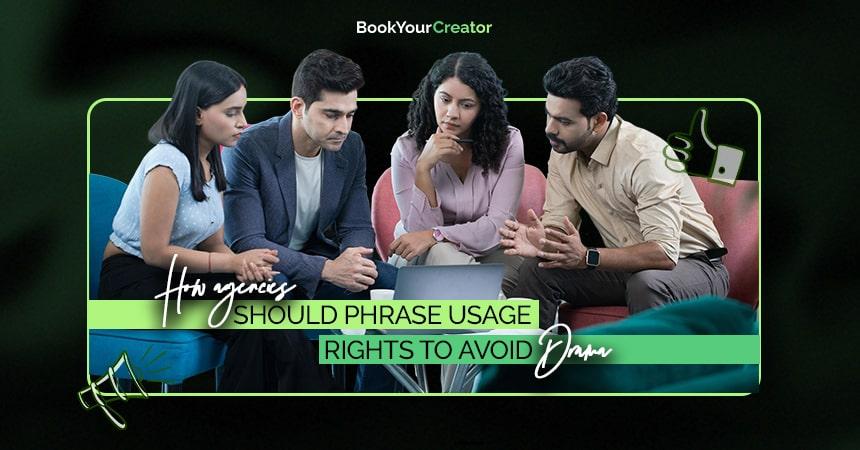
- 11 Nov, 2025
How Agencies Should Phrase Usage Rights to Avoid Drama
One unclear sentence in a contract can cost thousands, or a partnership.
In influencer marketing, “usage rights” are often where things go wrong.
A creator might deliver a campaign, only to later find their content running as a paid ad, without consent or extra payment.
That’s when a smooth collaboration turns into public drama or legal trouble.
The good news: most of this can be avoided if agencies phrase usage rights clearly and respectfully.
Here’s how to do it right, so both brands and creators stay protected.
1. Don’t Hide Usage Rights in Fine Print
Many contracts say something like: “the brand may use content across all media, in perpetuity.”
That one phrase can mean forever, anywhere, for anything, and that’s where most misunderstandings begin.
Better phrasing example:
“The brand may repost or repurpose the content across its owned digital channels (website, social media, email) for up to six (6) months after the campaign ends, with proper creator credit.”
This version is clear, time-bound, and platform-specific—aligned with industry standards.
According to recent legal guidance in India, clear usage-rights terms must be set out in influencer agreements. Influencer Marketing Hub+3awmlegal.in+3legal-veda.com+3
2. Define Duration, Territory & Platforms Clearly
Usage rights aren’t one-size-fits-all. Every contract should specify three key points:
Element | What to Define | Why it Matters |
Duration | How long the brand can use the content | Prevents indefinite (and unexpected) use |
Territory | Where the content can be used | Controls geographic scope & brand market risk |
Platforms | Which channels the content appears on | Ensures creator knows exactly where their work shows |
Example phrasing:
“Usage rights extend for six (6) months across brand-owned digital platforms in India only. Paid media usage (ads, boosts, or sponsored placements) requires separate written approval.”
Being clear on these three elements prevents most contract-related confusion.
3. Separate “Organic Use” from “Paid Use”
One of the biggest pain points:
Creators grant content for organic use (brand reposts, pages, stories), but paid use (ads, boosted posts) is a different deal entirely.
Example phrasing:
“Any use of the creator’s content for paid advertising, including boosted posts or sponsored placements, will require separate written consent and additional fees.”
Clear separation helps both sides avoid misalignment and protects creator rights.
4. Get Consent for Face, Voice & Likeness
Even if a brand pays for campaign content, the creator still owns their likeness, their face, voice, image.
Using that likeness in new or unexpected contexts (especially third-party or beyond the campaign) is risky.
Example phrasing:
“The brand may use the creator’s likeness only within the agreed campaign materials. Any third-party or commercial endorsement use requires separate written consent.”
This small clause protects creators and keeps trust strong.
5. Add Renewal or Buy-out Options Upfront
Sometimes the campaign performs well, and the brand wants to keep using the content. That’s good, as long as it’s mutually agreed and compensated.
Example phrasing:
“The brand may request renewal of usage rights beyond the original term at mutually agreed rates. Any extended or perpetual use requires a new written agreement.”
This approach lets you keep flexibility without ambiguity.
6. Avoid “Perpetual” or “In Perpetuity” Unless It’s Paid For
“Perpetual rights” mean forever. If a brand truly needs lifetime rights (for example, evergreen brand films or testimonials), it should be a buy-out with clear compensation.
Better phrasing:
“Perpetual usage rights may be granted upon full buy-out of content rights, with compensation reflecting lifetime use.”
This phrasing keeps things fair and transparent.
7. Use Human Language, Not Legalese
Contracts shouldn’t feel like they were written only for lawyers. Most creators aren’t lawyers, they’re storytellers and entrepreneurs.
Using plain English builds trust and avoids misinterpretation.
Example:
Instead of:
“The parties hereto agree to irrevocable transfer of all rights in perpetuity,”
Use:
“The creator grants the brand permission to use this video for six (6) months on Instagram and YouTube.”
Simple. Clear. Respectful.
8. Keep It Mutual, Protect Both Sides
Usage-rights clauses don’t exist to restrict creators, they exist to provide clarity to both sides.
Good contracts protect the creator’s work and give the brand what it needs. That balance builds long-term partnerships.
“Clarity doesn’t restrict creativity, it protects it.”
Sample Usage Rights Clause
The Brand may repost the Creator’s approved content on its owned social media channels
(Instagram, Facebook, Website) for a period of six (6) months after campaign completion.
Any paid promotions, ad usage, or third-party distribution will require separate written
consent and additional compensation.
Use this as a baseline and adapt it to your campaign’s specifics.
Final Thoughts: Clarity Is the New Currency
Usage rights don’t have to be complicated or controversial.
When agencies define them clearly:
Brands get the freedom they need.
Creators feel protected and respected.
Partnerships run smoother and stay drama-free.




